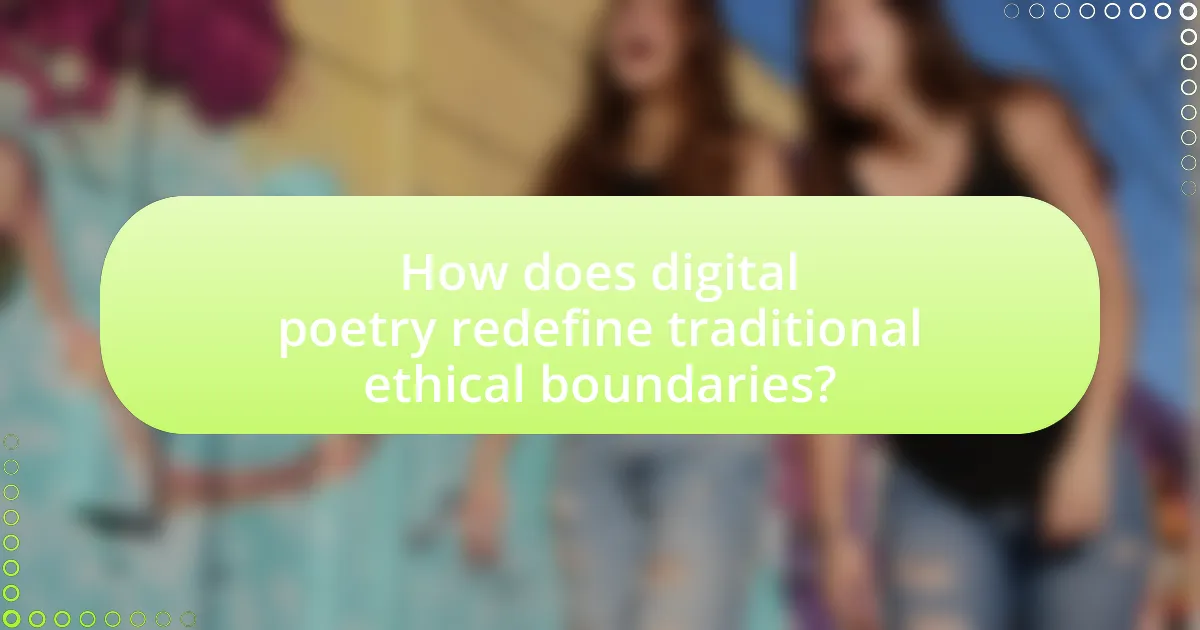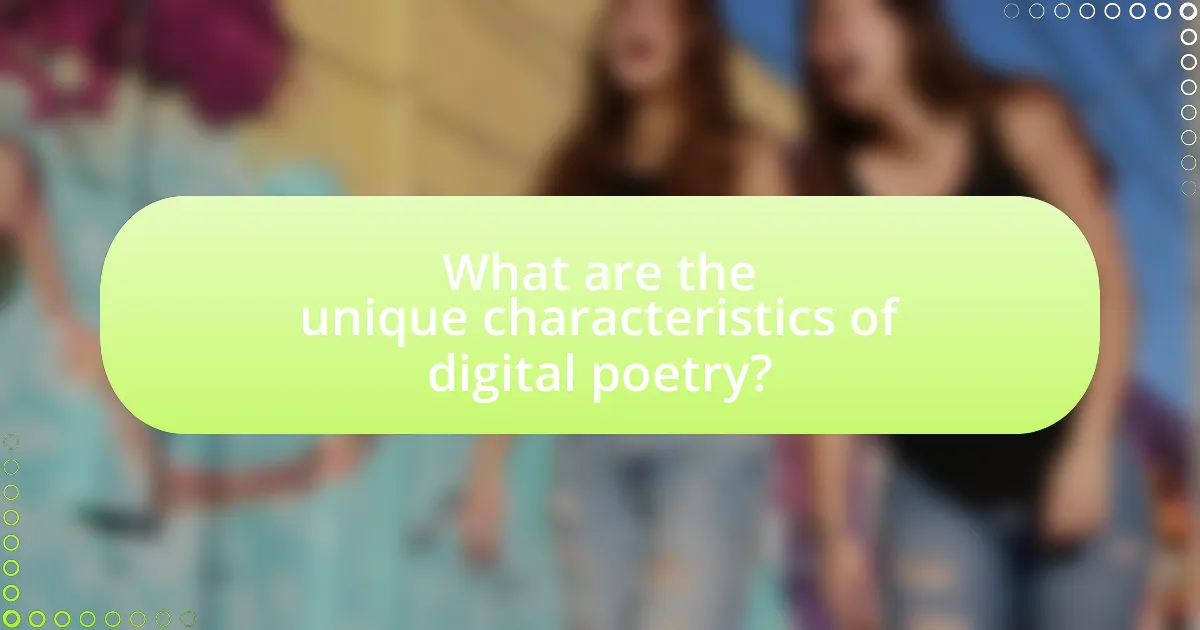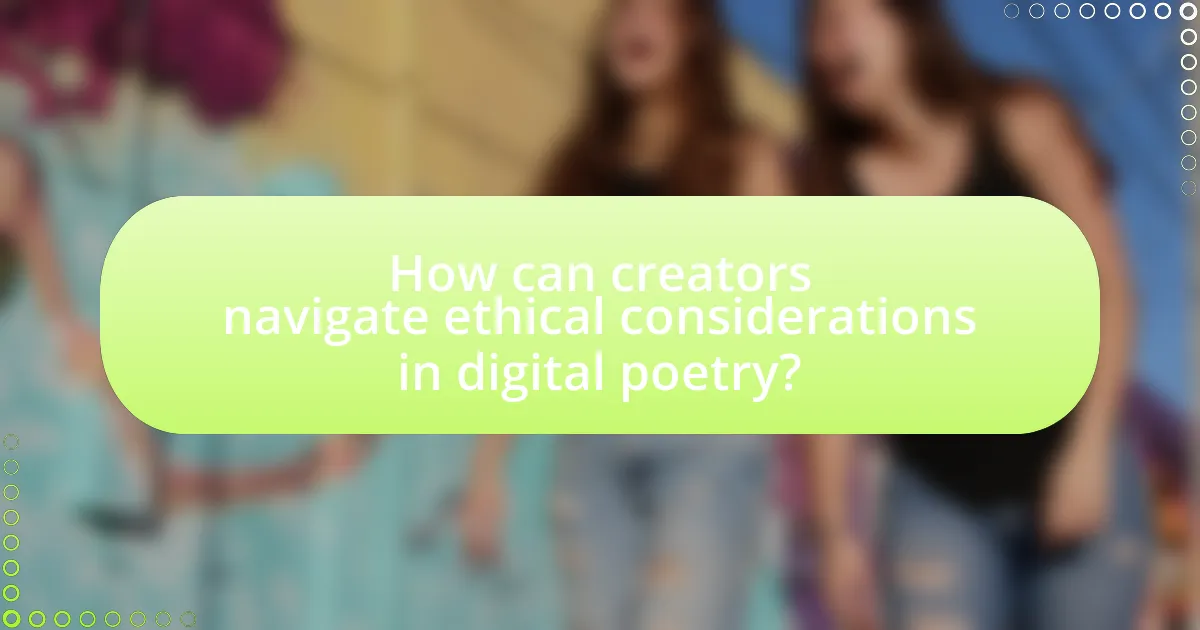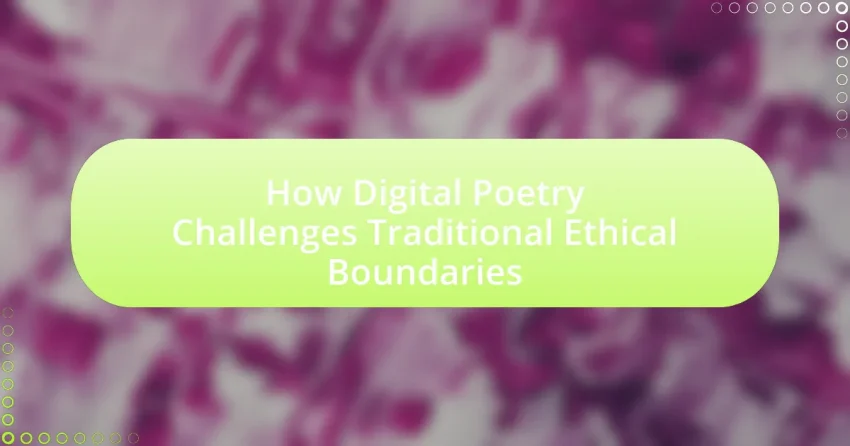Digital poetry is a contemporary form of artistic expression that utilizes technology to challenge and redefine traditional ethical boundaries related to authorship, originality, and audience engagement. This article explores how digital poetry incorporates multimedia elements and interactivity, leading to collaborative creation and raising ethical dilemmas surrounding copyright and misrepresentation. It examines the implications of digital poetry on societal norms, representation, and activism, while also addressing the unique characteristics and potential risks associated with this evolving art form. Additionally, the article provides guidelines for ethical practices in digital poetry creation, emphasizing the importance of originality, consent, and community engagement.

How does digital poetry redefine traditional ethical boundaries?
Digital poetry redefines traditional ethical boundaries by utilizing technology to challenge authorship, originality, and the role of the audience. This form of poetry often incorporates multimedia elements, allowing for collaborative creation and reinterpretation, which blurs the lines of individual ownership and intellectual property. For instance, works like “The Uncreative Writing” by Kenneth Goldsmith emphasize the idea of appropriation in digital poetry, where existing texts are remixed and transformed, raising questions about the ethics of originality and copyright. Additionally, the interactive nature of digital poetry invites audience participation, shifting the ethical responsibility of interpretation and meaning-making from the poet to the reader, thereby redefining the traditional roles within literary creation.
What ethical dilemmas arise from digital poetry?
Digital poetry presents several ethical dilemmas, primarily concerning authorship, copyright, and the potential for misrepresentation. The rise of digital platforms allows for easy manipulation and distribution of poetic works, which can lead to issues of plagiarism and the unauthorized use of an artist’s intellectual property. For instance, when a digital poem is altered or remixed, it raises questions about the original creator’s rights and the integrity of their work. Additionally, the accessibility of digital poetry can blur the lines between original content and derivative works, complicating the attribution of authorship. Furthermore, the anonymity afforded by online platforms can lead to misrepresentation, where individuals may present others’ work as their own, undermining the ethical standards of artistic expression. These dilemmas highlight the need for clear guidelines and ethical considerations in the evolving landscape of digital poetry.
How does digital poetry challenge authorship and ownership?
Digital poetry challenges authorship and ownership by enabling collaborative creation and remixing, which complicates traditional notions of individual authorship. In digital environments, multiple users can contribute to, alter, and share poetic works, leading to a collective authorship model that contrasts with the singular creator concept prevalent in print literature. This shift is evidenced by platforms like Twitter and Tumblr, where users often build upon each other’s work, creating a shared cultural text rather than a distinct, owned piece. Additionally, the ease of copying and distributing digital content raises questions about intellectual property rights, as seen in debates surrounding Creative Commons licenses, which allow for varying degrees of sharing and modification. These factors collectively disrupt established frameworks of ownership, prompting a reevaluation of how authorship is defined in the digital age.
What implications does digital poetry have on copyright laws?
Digital poetry raises significant implications for copyright laws by challenging the traditional definitions of authorship and originality. The unique characteristics of digital poetry, such as interactivity and multimedia elements, complicate the attribution of ownership, as these works often incorporate various forms of existing content, including text, images, and sounds. For instance, the U.S. Copyright Office recognizes that digital works can be derivative, which means that they may not qualify for copyright protection if they heavily rely on pre-existing materials without sufficient transformation. This situation creates legal ambiguities regarding the rights of creators and the potential for infringement, as the blending of multiple media forms can blur the lines of originality. Consequently, digital poetry necessitates a reevaluation of copyright frameworks to accommodate the evolving landscape of creative expression in the digital age.
In what ways does digital poetry influence societal norms?
Digital poetry influences societal norms by reshaping communication, democratizing artistic expression, and challenging traditional literary forms. Through platforms like social media, digital poetry allows diverse voices to be heard, fostering inclusivity and representation in literature. For instance, the rise of hashtags and online poetry communities has enabled marginalized groups to share their experiences, thereby influencing societal perceptions and discussions around identity and culture. Additionally, digital poetry often incorporates multimedia elements, which can provoke new ways of thinking about language and meaning, pushing against conventional boundaries of poetry and art. This evolution in form and accessibility has led to a broader acceptance of varied poetic expressions, ultimately contributing to shifts in societal norms regarding creativity and self-expression.
How does digital poetry address issues of representation and inclusivity?
Digital poetry addresses issues of representation and inclusivity by utilizing diverse voices and multimedia elements to create a more accessible and varied literary landscape. This form of poetry often incorporates visual art, sound, and interactive features, allowing marginalized voices to express their experiences in innovative ways. For instance, platforms like Instagram and Twitter have enabled poets from underrepresented communities to reach wider audiences, fostering inclusivity. Research indicates that digital poetry can democratize literary expression, as seen in the rise of poets like Rupi Kaur, who blends personal narrative with cultural themes, thus challenging traditional literary norms and promoting representation.
What role does digital poetry play in activism and social justice?
Digital poetry serves as a powerful tool for activism and social justice by amplifying marginalized voices and fostering community engagement. It utilizes accessible platforms to disseminate messages that challenge societal norms and injustices, often addressing issues such as inequality, discrimination, and human rights violations. For instance, during the Black Lives Matter movement, digital poetry became a medium for expressing collective grief and resistance, with poets like Amanda Gorman gaining widespread recognition for their impactful works. This form of poetry not only raises awareness but also encourages dialogue and mobilization, making it a vital component of contemporary social movements.

What are the unique characteristics of digital poetry?
Digital poetry is characterized by its integration of multimedia elements, interactivity, and non-linear narratives. These characteristics allow digital poetry to transcend traditional textual forms, enabling the use of visuals, sounds, and animations to enhance the poetic experience. For instance, the incorporation of hyperlinks can create a web of meanings, allowing readers to navigate through different interpretations and layers of the poem. Additionally, the interactive nature of digital poetry invites audience participation, where readers can influence the outcome or structure of the poem, further blurring the lines between creator and audience. This evolution in form and engagement challenges conventional ethical boundaries by redefining authorship and the role of the reader in the poetic process.
How does interactivity shape the experience of digital poetry?
Interactivity significantly shapes the experience of digital poetry by allowing readers to engage actively with the text, transforming them from passive consumers into co-creators. This engagement can manifest through various forms, such as clickable elements, multimedia integration, and user-generated content, which enhance the emotional and intellectual connection to the poem. For instance, studies have shown that interactive features can lead to deeper comprehension and retention of poetic themes, as users navigate through different interpretations and layers of meaning. This participatory nature of digital poetry challenges traditional ethical boundaries by inviting diverse perspectives and interpretations, thus democratizing the poetic experience and questioning authorship and ownership in literary creation.
What technologies are commonly used in creating digital poetry?
Common technologies used in creating digital poetry include programming languages, multimedia software, and web platforms. Programming languages such as JavaScript and Python enable poets to create interactive and algorithmic poetry, allowing for dynamic text generation and manipulation. Multimedia software like Adobe Creative Suite facilitates the integration of visual elements, sound, and animation, enhancing the poetic experience. Additionally, web platforms such as WordPress and social media allow poets to publish and share their work widely, reaching diverse audiences. These technologies collectively expand the possibilities of poetic expression beyond traditional print formats.
How does the format of digital poetry differ from traditional poetry?
Digital poetry differs from traditional poetry primarily in its use of multimedia elements and interactive features. While traditional poetry typically relies on text and structured forms, digital poetry incorporates visuals, audio, and hypertext, allowing for a more immersive experience. For instance, digital poetry can include animations or soundscapes that enhance the emotional impact of the words, which is not possible in print formats. This integration of technology enables readers to engage with the poem in a nonlinear fashion, often allowing them to navigate through different paths or interpretations, unlike the fixed structure of traditional poetry.
What are the potential risks associated with digital poetry?
The potential risks associated with digital poetry include issues of copyright infringement, loss of authenticity, and the potential for digital manipulation. Copyright infringement arises when digital poets use existing works without proper attribution, leading to legal consequences. Loss of authenticity occurs as digital formats can alter the original intent and emotional impact of poetry, potentially diluting its value. Additionally, digital manipulation can misrepresent the poet’s voice or message, creating ethical dilemmas regarding authorship and integrity. These risks highlight the need for careful consideration of ethical boundaries in the digital poetry landscape.
How can digital poetry perpetuate misinformation or harmful narratives?
Digital poetry can perpetuate misinformation or harmful narratives by utilizing ambiguous language and emotive imagery that can mislead audiences. The inherent brevity and stylistic freedom of digital poetry often allow for interpretations that stray from factual accuracy, enabling the spread of false information. For instance, a study by the Pew Research Center indicates that emotionally charged content is more likely to be shared online, which can amplify misleading poetic expressions. Additionally, the lack of editorial oversight in digital platforms means that unverified or harmful narratives can gain traction without scrutiny, further entrenching misinformation within the digital poetry landscape.
What are the challenges of preserving digital poetry for future generations?
The challenges of preserving digital poetry for future generations include technological obsolescence, format degradation, and the ephemeral nature of digital platforms. Technological obsolescence occurs as software and hardware evolve, rendering older formats inaccessible; for instance, many early digital poems were created in Flash, which is no longer supported. Format degradation refers to the loss of data integrity over time, as file formats may become corrupted or unsupported. Additionally, the ephemeral nature of digital platforms means that poems hosted on websites can disappear if the site is taken down or if the hosting service ceases to exist. These factors collectively threaten the longevity and accessibility of digital poetry, making it difficult for future generations to experience this art form as originally intended.

How can creators navigate ethical considerations in digital poetry?
Creators can navigate ethical considerations in digital poetry by adhering to principles of originality, consent, and transparency. Originality ensures that creators avoid plagiarism by producing unique works, which is crucial in maintaining integrity within the digital space. Consent involves obtaining permission from individuals whose work, likeness, or ideas are incorporated into digital poetry, thereby respecting their rights and contributions. Transparency requires creators to disclose their methods and sources, fostering trust with their audience. These practices are supported by copyright laws that protect original works and ethical guidelines established by literary organizations, emphasizing the importance of ethical standards in creative expression.
What best practices should poets follow when creating digital works?
Poets should prioritize accessibility, interactivity, and originality when creating digital works. Accessibility ensures that their poetry reaches a wider audience, which can be achieved by using clear language and considering various formats, such as audio or visual elements. Interactivity engages readers, allowing them to participate in the experience, which can enhance emotional connection and understanding. Originality is crucial in a digital landscape saturated with content; poets must strive to present unique perspectives and innovative forms that challenge conventional boundaries. These practices not only enhance the reader’s experience but also align with the evolving nature of digital media, as evidenced by the increasing popularity of interactive poetry platforms and multimedia storytelling.
How can poets ensure ethical sourcing of materials in their digital poetry?
Poets can ensure ethical sourcing of materials in their digital poetry by utilizing original content, obtaining proper licenses for copyrighted materials, and giving credit to sources. Original content creation eliminates the risk of plagiarism and respects intellectual property rights. When using existing works, poets should acquire licenses or permissions, as demonstrated by the Creative Commons licensing system, which allows creators to share their work legally while retaining certain rights. Additionally, proper attribution to the original authors or creators fosters transparency and acknowledges their contributions, aligning with ethical standards in creative practices.
What guidelines exist for respecting cultural appropriation in digital poetry?
Guidelines for respecting cultural appropriation in digital poetry include obtaining permission from cultural representatives, acknowledging the source culture, and ensuring accurate representation of cultural elements. These practices help prevent misrepresentation and exploitation of marginalized cultures. For instance, the “Cultural Appropriation and the Arts” report by the American Anthropological Association emphasizes the importance of consent and collaboration with cultural communities to foster respectful engagement.
What resources are available for understanding ethics in digital poetry?
Resources available for understanding ethics in digital poetry include academic journals, books, online courses, and conferences focused on digital literature and ethics. Notable academic journals such as “Digital Creativity” and “Literary and Linguistic Computing” publish research on the intersection of ethics and digital poetry. Books like “Digital Poetics: An Open Invitation to the Digital Humanities” by Loss Pequeño Glazier provide foundational insights into ethical considerations. Online platforms like Coursera and edX offer courses that explore digital literature, including ethical implications. Additionally, conferences such as the “Digital Humanities Conference” often feature discussions on ethical boundaries in digital poetry, providing a collaborative space for scholars and practitioners to share insights and research.
How can poets engage with communities to foster ethical practices?
Poets can engage with communities to foster ethical practices by creating collaborative projects that address social issues and promote dialogue. For instance, community poetry workshops can encourage participants to express their experiences and perspectives, fostering a sense of belonging and understanding. Research indicates that participatory art initiatives, such as those led by poets, can enhance community cohesion and empower marginalized voices, thereby promoting ethical awareness and responsibility. A study by the National Endowment for the Arts found that community engagement in the arts leads to increased civic participation and social capital, demonstrating the effectiveness of poets in driving ethical practices through their work.
What organizations provide support for ethical digital poetry creation?
Organizations that provide support for ethical digital poetry creation include the Electronic Literature Organization (ELO), which promotes the creation and dissemination of electronic literature, and the Poetry Foundation, which offers resources and grants for innovative poetic forms. Additionally, the National Endowment for the Arts (NEA) funds projects that explore new media in poetry, ensuring ethical practices in digital creation. These organizations contribute to the ethical landscape by advocating for fair use, copyright awareness, and the responsible use of technology in poetry.
